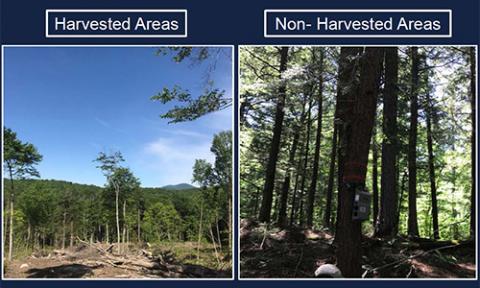Imperiled Bats in Northeastern Forests: Balancing Bat Conservation with Forest Management

Several northeastern bat species have experienced significant population declines due in large part to the effects of white-nose syndrome. There has been limited research investigating summer habitat use of bats in managed forests in the Northeastern U.S. Thus, there is limited information to guide decisions makers and forest managers on what practices and conditions are compatible with bat habitat needs, how to manage forests to maintain or enhance bat habitat, or determine what practices limit negative impacts.
In this study NSRC researchers investigated what bat species were present across a range of stand conditions and determined what forest characteristics bats use in managed forests. In summer 2017–2018, they conducted repeated acoustic bat surveys at 126 sample points with a range of stand and landscape characteristics on managed forests in the Adirondack region of NY. Acoustic recordings were used to accurately identify bat species or, when bats with similar calls were not distinguishable, they used phonic groups (groups of similar bats). Contemporary statistical techniques were used to address the challenges of effectively detecting bats and to statistically test what forest features were associated with use by one or more bat species.
Researchers found all bats were more likely to use areas with less tree canopy cover. High-frequency bats (i.e. bats with similar high frequency calls, primarily Myotis species) were more likely to use recently-harvested sites (<10 years since harvest) or mature stands, rather than intermediate stages. Results support the idea that managed forests, including forests managed for harvest, can be compatible with bat habitat needs. Use of even-aged forest management practices to regenerate forests can provide suitable habitat for foraging bats in the Adirondacks.
